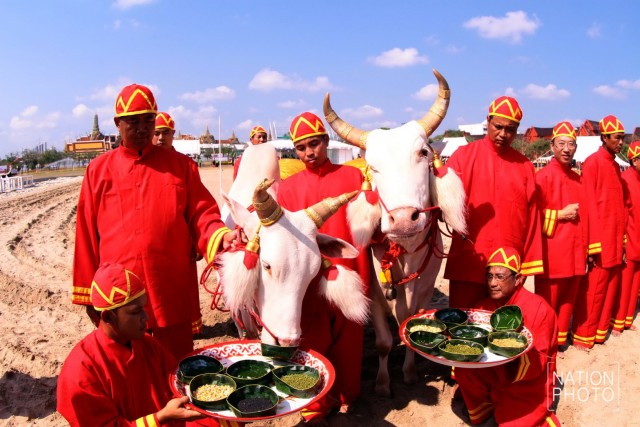The Royal Ploughing Ceremony
The Royal Ploughing Ceremony The annual Ploughing Ceremony usually takes place in May every year at Sanam Luang near the Grand Palace in Bangkok. The ceremony has been performed since ancient times and designed to give an auspicious beginning to the new planting season. In fact, the Ploughing Ceremony is of Brahman origin and it was practised even before the birth of Lord Buddha who, then a Prince, used to take part in the ceremony. The auspicious day and time are to set by the Royal Brahman astrologers. Nowadays, although Their Majesties are present at the ceremony, the King no longer takes the leading role, His Majesty the King appoints the Ploughing Lord as his representative to carry out the rites.
During this colourful ceremony, the amount of rainfall to be expected in the coming season is forecast. The Ploughing Lord is offered a choice of three lengths of cloth, all looking identical, if his choice is the longest one there will be little rain during the coming year; if it is the shortest one, rain will be plentiful while the one of medium length indicates average rain. After donning the piece of cloth, called “Panung”, the Ploughing Lord then ploughs furrows in Sanam Luang with a sacred plough of red and gold drawn by sacred white bulls and followed by four consecrated ladies who carry gold and silver baskets filled with rice seed. Walking alongside the plough are Brahmans who are chanting and blowing conch shells.
When the ploughing is finished the bulls are presented with seven different foods and drink, i.e. rice seed, beans, maize, hays, sesame seed, water and alcoholic liquor. Whatever the bulls choose to eat or drink, it is forecast that this will be plentiful during the year. After the ceremony has ended, the crowds scramble for the seeds sown by the Ploughing Lord as the seeds are regarded as things that twill bring the owners wealth and good luck. The farmers will mix the seeds with their own rice to ensure a good crop in the coming year.














0 ความคิดเห็น:
แสดงความคิดเห็น